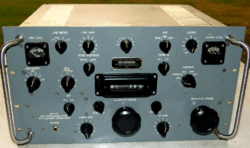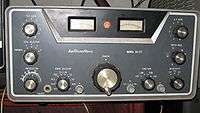Communications receiver

A communications receiver is a type of radio receiver used as a component of a radio communication link. This is in contrast to a broadcast receiver which is used to receive radio broadcasts. The difference between the two is that broadcast receivers only receive broadcast bands, such as the medium wave and/or longwave AM broadcast bands and the VHF FM broadcast band, while a communication receiver receives a wider part of the radio spectrum not used for broadcasting, that includes the shortwave bands. They are often used with a radio transmitter as part of a two way radio link for shortwave radio or amateur radio communication, although they are also used for shortwave listening.
Features
Commercial communications receivers are characterized by high stability and reliability of performance, and are generally adapted for remote control and monitoring. For marketing purposes, many hobby-type receivers are advertised as a "communications receivers" although none are suited for heavy-duty, reliable 24-hour use as the primary form of communication for an isolated station.
Typically, a communications receiver is of the superheterodyne type in double, triple or, more rarely, quad conversion. It features multiple RF and IF amplification stages and may have at least one IF stage that is crystal controlled. It usually has a BFO and a product detector for SSB and CW reception. The frequency coverage of receivers of this type is typically in the range of 500 kHz to 30 MHz. Communication receivers are suited for operation near powerful transmitting facilities and so must have good internal shielding, front-end filtering. They have design features to provide high selectivity and stability. Rejection of unwanted signals (images, intermodulation products) will typically be much greater than a consumer-type general coverage or broadcast receiver.
The front panel controls are typically more comprehensive than those on a broadcasting receiver. Usual features include: signal strength meter; RF gain control; AVC/AGC adjustments; band switching or preselector switching; selectable bandwidth filters; BFO tuning; audio limiters or attenuators. Precise, calibrated, analog tuning and display dials are used, with a separate bandspread control to allow selective tuning of signals close in frequency. In more recent units electronic digital frequency displays are provided. In communication receivers, the decorative wooden cabinets typical of early broadcast receivers were replaced with utilitarian metal cabinets to provide electromagnetic shielding and mechanical ruggedness.[1]
Communications receivers as an identifiable product type originated in 1933.[1] The older generation of tube-based communications receivers are affectionately known as boatanchors for their large size and weight. Such receivers include the Collins R-390 and R-390A, the RCA AR-88, the Racal RA-17L and the Marconi Electra. However, even modern solid-state receivers can be very large and heavy, such as the Plessey PR2250, the Redifon R551 or the Rohde & Schwarz EK070/D2-80.[2]
Photo gallery
 BC-224-D, U.S. military variant of BC-348, c. 1940s
BC-224-D, U.S. military variant of BC-348, c. 1940s Hallicrafters SX-28 Super Skyrider receiver, c. 1940s
Hallicrafters SX-28 Super Skyrider receiver, c. 1940s Eddystone Ec. 10, c. 1950s
Eddystone Ec. 10, c. 1950s Drake 2B, c. 1960s
Drake 2B, c. 1960s Collins Radio R-390A, 1955
Collins Radio R-390A, 1955 Hallicrafters SX-115, c. 1960s
Hallicrafters SX-115, c. 1960s Hallicrafters SX-117, c. 1960s
Hallicrafters SX-117, c. 1960s- Drake R4B, c. 1971
 Icom IC R-71R, c. 1980s
Icom IC R-71R, c. 1980s AKD Target HF-4E, c. 1980s
AKD Target HF-4E, c. 1980s Icom RC-9500, 2000s
Icom RC-9500, 2000s Perseus SDR receiver, 2009
Perseus SDR receiver, 2009
See also
References
- 1 2 Jerome S. Berg, On the Short Waves, 1923-1945: Broadcast Listening in the Pioneer Days of Radio, McFarland, 2007; ISBN 078643029X page 121
- ↑ Shortwave Receivers Past and Present: Communications Receivers, 1942-1997, by Fred Osterman. Published by Universal Radio Research, 1998. ISBN 1-882123-07-7, ISBN 978-1-882123-07-0
Further reading
| Wikimedia Commons has media related to Communications receivers. |
- Osterman, Fred (1998). Shortwave Receivers Past & Present: Communications Receivers 1942-1997. Universal Radio Research, Reynoldsburg (USA).
- Ulrich L. Rohde, Jerry Whitaker. Communications Receivers, Third Edition. McGraw Hill, New York, NY, 2001. ISBN 0-07-136121-9.